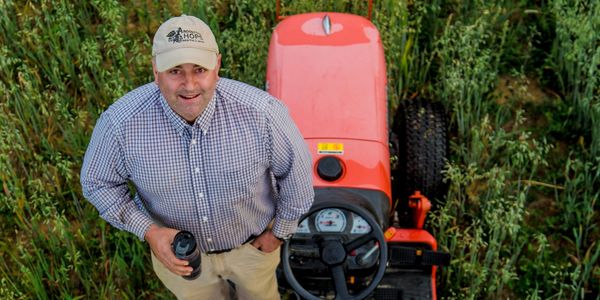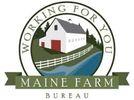Our team
Jason Johnston
Krista Delahunty
Krista Delahunty

Jason Johnston grew up in Aroostook county and graduated from Presque Isle High School. After pursuing Biology and Environmental Science degrees at Bowdoin, Delaware and UMaine, he was hired as a wildlife ecology professor at UMaine-Presque Isle. He conducts research, along with UMPI students, on topics related to birds and forest ecology. When not working, fixing up the farmhouse, or spending time with family, he occasionally goes fly-fishing.
Krista Delahunty
Krista Delahunty
Krista Delahunty
Originally from St. John’s, Newfoundland, Canada, Krista moved to Maine after completing a Master of Science degree at Memorial University of Newfoundland to work at the Jackson Lab in Bar Harbor, ME. Besides being a hop farmer, she also teaches online Biology part-time at the University of Maine at Presque Isle while taking care of three girls and keeping up with their many extracurricular activities.
The Little Helpers
Kathleen
Kathleen
Kathleen

Kathleen is 10 years old and is becoming a great help around the farm. She takes her turn picking leaves off the harvester belt and has become an excellent tractor driver, hauling Dad on a 14-foot tall platform mounted to a trailer through some tight pole spacing. She is a proud “County girl”!
Marie
Kathleen
Kathleen

Marie is 7 years old and also works on the harvester picking leaves, though her favorite job is shoveling pelletized chicken manure in the spring.
Elise
Elise
Elise

Elise is almost 2 years old and is mostly learning the ropes by watching her big sisters from her stroller and helps with hop harvest by taking naps. She does seem to have an interest in quality control, and likes to critically sniff the hop cones to check if they are ready yet.
Annie
Elise
Elise

Annie is a 2-year-old border collie x blue heeler mix who keeps a close eye from the dining room window on the sheep grazing in the hopyard inside their electric fence.
Our Mission
Organic
Organic
Organic
Our organic farming practices favor human health, microbial soil growth, and biodiversity, while minimizing negative habitat effects.
No synthetic chemicals.
All natural inputs.
USDA-certified.
Local
Organic
Organic
With over 90% of all US hops grown in the Pacific Northwest, we are excited to be able to provide Maine’s ever-growing brewing industry with quality local Maine hops. Mainers care about eating and drinking local ingredients, and more and more neighborhood brewpubs are opening to provide the Maine-grown products that consumers are really interested in.
Terroir
Organic
Terroir
Just like with wine, hops have a “terroir” and take on unique flavor characteristics based on the soil and climate they are grown in. Our northern Maine-produced Cascade taste a little different than the Pacific Northwest Cascade hops, which we think makes them very interesting... and brewers do, too!
Our Operation
The hopyard
Mobile platform
Mobile platform

The most visually striking thing about driving by our hopyard is the 18-foot tall trellis system. Hundreds of poles support tens of thousands of feet of metal cable, all anchored at the perimeter with guywires. Hop plants are perennial, and grow up coir strings to the top of the trellis each year before being cut down to be run through the harvester.
Mobile platform
Mobile platform
Mobile platform

We spend a lot of time up high throughout the year, accessing the top of the trellis for cable work, spring stringing, and cutting down the plants in the fall. Our 14 foot tall platform is mounted to a trailer and gets towed behind our small tractor. During harvest season, it's where we view the sunrise from each morning!
Irrigation
Mobile platform
Our harvester

Our plants are irrigated extensively with a dedicated well that runs through buried PVC into a drip tape fertigation system. We worked with the USDA Natural Resource Conservation Service (NRCS) in planning and designing the best system for our hopyard. This allows us to provide adequate water (hops are a thirsty crop!) and deliver nutrients through our fertigation setup.
Our harvester
Our harvester
Our harvester

The design for our mechanical harvester was originally constructed by Chris Callahan, UVM’s Agricultural Engineer. We produced a beta version from his open-sourced plans which was fabricated locally by Maineline Welding & Fabrication in Blaine, ME. This was partially funded by a Maine Technology Institute (MTI) grant.
Pelletizing
Our harvester
Pelletizing

Our PM810 hop pelletizing system from Buskirk Engineering allows us to make great quality hop pellets at low temperatures. With some machines, hops can encounter high temperatures due to friction, resulting in a low quality pellet that has degraded oils. Temperatures stay low during pelletizing on our Buskirk machine due to their high torque, low RPM design. Finished pellets are immediately placed on mesh trays with air fanned from below to quickly cool and condition them prior to packaging.
The sheep
Our harvester
Pelletizing

We use sheep as sustainable helpers in weed and downy mildew management. Without use of synthetic herbicides like Round-Up, weeds can get to be a problem in an organic hopyard. Enter sheep! Once the hop bines are grown tall enough, we graze sheep from our neighbor’s farm intensively until they clean up all the weeds, the suckers at the base of the hop plants, and defoliate the lower part of the bine as far as they can reach – all without damaging the bine itself. Then we move them on to the next section of hops, where they do it all again...
See how our hops are harvested
Watch hop pellets being made
We are members of











